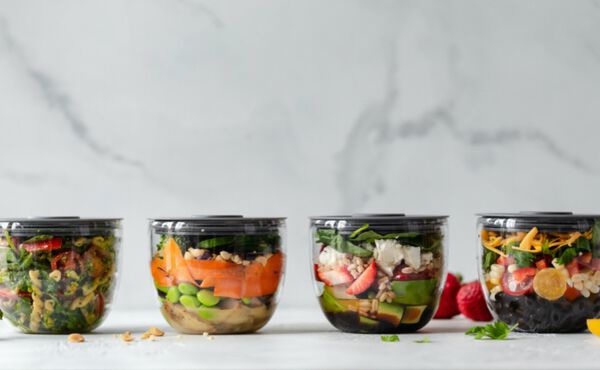Let’s start off with a bang, ‘if you want to save the world, change what you eat’. There, I said it. But it’s probably not news to you, right? You probably already knew that food is the one area in your life where even small changes can have massive impacts. Because, if you think about it, you eat a lot in your life, 3-4 meals a day, perhaps even a healthy snack or two? So really, any dietary decisions and changes you make will be multiplied by 365 days in a year, and that’s just thanks to the efforts of one person: you. And let’s not forget the many health benefits some foodie changes can bring you and how much cheaper it can be as well. We’ve rounded up just a few food-related tricks you can easily implement from the comfort of your own kitchen that are healthy for you and the planet.
- Go Green
Between 20 – 30% of global warming caused by human activity is actually contributed by our food and agriculture systems. But, eating just one plant-based meal a day for a year can save 200.000 gallons of water and the carbon equivalent of driving from LA to NY. As for your own health, the majority of research has linked plant-based diets to lower rates of heart disease, type 2 diabetes, and weight loss when compared with diets high in meat and other animal products. Consuming real, whole foods (organic and sustainably sourced if possible) eliminates empty calories and increases your nutritional intake, which in turn boosts your immune system and overall well-being. Your shopping list should contain sustainable or organic fresh produce whenever possible, such as fruits, veggies, nuts, seeds, beans, whole grains, olive oil, fish, eggs and (less) meat.
- Cut down on meat and diary
It’s well known that the livestock sector is a big carbon emissions contributor – producing as much as all cars, trucks and automobiles combined – and cutting down on your meat intake, or forgoing it entirely, can have an immensely positive impact on both you and the earth. If going vegetarian might be too abrupt of a change, consider a flexitarian diet. The idea is that you consume meat for one meal and eat vegan for the other two main meals of the day. Some actually consider this more balanced than going vegetarian completely, because it cuts down on more than just meat consumption, it also limits your dairy and egg intake – an industry which also negatively impacts the environment.

- Meal planning eliminates food waste as well as the munchies
Meal planning can also help save on food waste and save you from the munchies. It ensures you make fewer trips to the grocery store, spend less money on food and eat healthier. You only buy what you’ve planned for and everything gets used – it’s essentially your personal food waste reduction strategy. Knowing what you’re going to eat when you come home, or step out of your home office, also helps you fight cravings or resist the urge to order food in.
- Fighting Food Waste
One third of all food produced – worldwide might I add – ends up in the bin says a 2017 study. The Greeks and Chinese throw away an average of 44 kgs per person, per year, the Russians average about 56 kgs, South Koreans 95 kgs, Canadians 123 kgs, Portuguese 135 kgs, Germans 154 kgs, the US 278 kgs, with Australians at the head of the charge with 361 kgs per person per year. A UN panel estimated that greenhouse emissions associated with food loss and waste – happening across the entire food chain – can be as high as 8 – 10% of all global emissions. What can you do to do your part to help limit food waste? Look around your neighbourhood for food waste initiatives that organise free food swaps between neighbours, link you to restaurants with leftovers they’d otherwise toss for just a couple of bucks, alert you to produce in your area that’s about to go off, or communities that ‘rescue’ the ugly veggies from farmers’ crops that you’d otherwise never see on the shelves of your local supermarket or on your plate at a restaurant. Check out Imperfect Foods, for example. There’s bound to be something near you, or just let your friends know whenever you’ve got leftovers you’re about to toss out.
- Go local
Some of the ingredients in that tasty dish you’re thinking of serving tonight could have more stamps on their passport than you do. Besides transportation, there are various stages in foodstuffs’ lifecycle that contribute to their carbon footprint, such as production, processing, storage & cooking, and finally: waste. So, shop at farmer’s markets, check labels at your supermarket, or look for local agriculture activities like city gardens or farmers that allow you to pick your own fruit and veg. One other thing to take into consideration: seasonality. While buying strawberries from a local farm in summer will have low emissions, shopping for local strawberries in winter will have a much larger footprint because of the energy and fertilizers necessary to produce them. Admittedly, it’s not always easy to find all produce and ingredients locally, but even just a little can go a long way.
- Know Your Origins
Okay, this might sound a little contrarian compared to no. 4 in this list. But researchers at the John Hopkins Center for a Livable Future concluded that local production isn’t always the best way to go from a climate change perspective. It’s not just the country of origin that has consequences for the climate, the efficiency of food growing, technology used, resources, etc. also impacts the amount of greenhouse gases produced. Co-author Martin Bloem explains that European soil, for example, is often more fertile, which makes production more efficient than in countries which have cut down forests to create grazing land. So, next time you buy your favourite cherry tomatoes, why not research the country of origin to see if you are choosing correctly?





